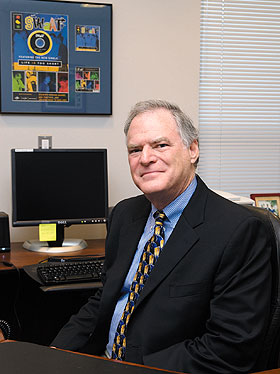  |
| HOME | THIS ISSUE | CALENDAR | GRANTS | BACK ISSUES | < BACK | NEXT > |
CHIP director's book explores social psychology of reconciliationby Beth Krane - March 2, 2009
|
||||
| Lasting resolutions to long-standing global conflicts will remain elusive until peace brokers address the emotional barriers to reconciliation, not just the equitable division of coveted resources, according to a new book with its roots at UConn. The Social Psychology of Intergroup Reconciliation, recently published by Oxford University Press, grew out of an international conference held at the Center for Health, Intervention and Prevention (CHIP) five years ago. “There has been a great deal of social sciences research conducted in the areas of conflict and conflict resolution, but an equally important area that has received little attention is reconciliation,” says Jeffrey D. Fisher, a professor of social psychology in the College of Liberal Arts and Sciences who is a co-editor of the book. “Our goal is to jump start a new field of research, to put the social psychology of reconciliation on the map.” Fisher is director of CHIP. “CHIP became involved in the conference and subsequent book because conflict and war obviously wreak a terrible toll on the physical and mental health of those on both sides,” Fisher adds. “Conflict resolution and reconciliation, on the other hand, create favorable health consequences.” The book’s other editors are Thomas E. Malloy, a professor at Rhode Island College, who earned a Ph.D. in social psychology from UConn in 1986, and Professor Arie Nadler of Tel Aviv University, a graduate school colleague and lifelong friend of Fisher’s. Nadler says years of conflict create emotional barriers to permanently ending the conflict, including distrust and possible feelings of humiliation. “If these emotional barriers are not removed,” he says, “even after an agreement for the division of resources has been achieved, the conflict is likely to simmer beneath what look like harmonious relations and erupt again.” The book distinguishes between instrumental and socio-emotional reconciliation. Instrumental reconciliation aims to build trust between the former adversaries in the present. Peace building projects in the Middle East in the post-Oslo Agreement years, in which Israelis and Palestinians were encouraged to work together toward common goals, are an example of an instrumental approach to reconciliation. A socio-emotional approach to reconciliation aims to dispel feelings of victimization or guilt through an apology-forgiveness cycle, perhaps best epitomized by the Truth and Reconciliation Commission in post-apartheid South Africa. The Commission invited former perpetrators to publicly take responsibility for past wrongdoings in return for readmission into the community. Palatable aid He highlights the U.S. government and pharmaceutical companies’ roll-out of anti-retroviral therapies to African countries hardest hit by the HIV epidemic, but says the concepts are broadly applicable to aid offered after a natural disaster or public health emergency.
“Unfortunately, emergency aid often doesn’t lead to the consequences the donor hopes for,” Fisher says. “In fact, the type of help most likely to be given is often the type most likely to lead to negative reactions.” For aid to lead to reconciliation, Fisher argues, it must be psychologically acceptable to the recipient. Because aid often flows from a more powerful donor to a less powerful recipient, it tends to be dependency-oriented, but the type of aid desired by the recipient is often autonomy-oriented. For instance, African countries initially did not respond favorably when the U.S. government, through the President’s Emergency Plan for AIDS Relief (PEPFAR), first funded anti-retroviral medicines for them because the countries could only use the funds to purchase brand name drugs, which cost 10 times as much as generics. “The countries were very frustrated that they were restricted to buying only brand name drugs with PEPFAR funds,” says Fisher. “Because of this, they could save far fewer lives and they would not be able to sustain the program once U.S. aid ended.” When the U.S. made generic versions of anti-retroviral therapies available, and even allowed countries such as South Africa and India to manufacture versions of the drugs themselves at far less cost, the distrust began to dissipate, he adds. Behavior change Within the context of the HIV epidemic and roll-out of anti-retroviral medicines, Fisher suggests the donor also should contribute a behavior change intervention that promote patient adherence to the medicines. He notes that this is a huge task to sustain over time. Non-adherence can have negative health consequences, especially the creation of drug-resistant strains of HIV, he says. In this scenario, both the recipient and the donor are making a substantial contribution to improving the recipient’s health, and that helps equalize their power in a way that opens the door for true reconciliation, Fisher says. Among the book’s other contributing authors with UConn ties are current or former social psychology professors Felicia Pratto, Reuben Baron, and John Dovidio, and recent Ph.D. graduates in psychology Tamar Saguy and Demis Glasford. |
| ADVANCE HOME UCONN HOME |

